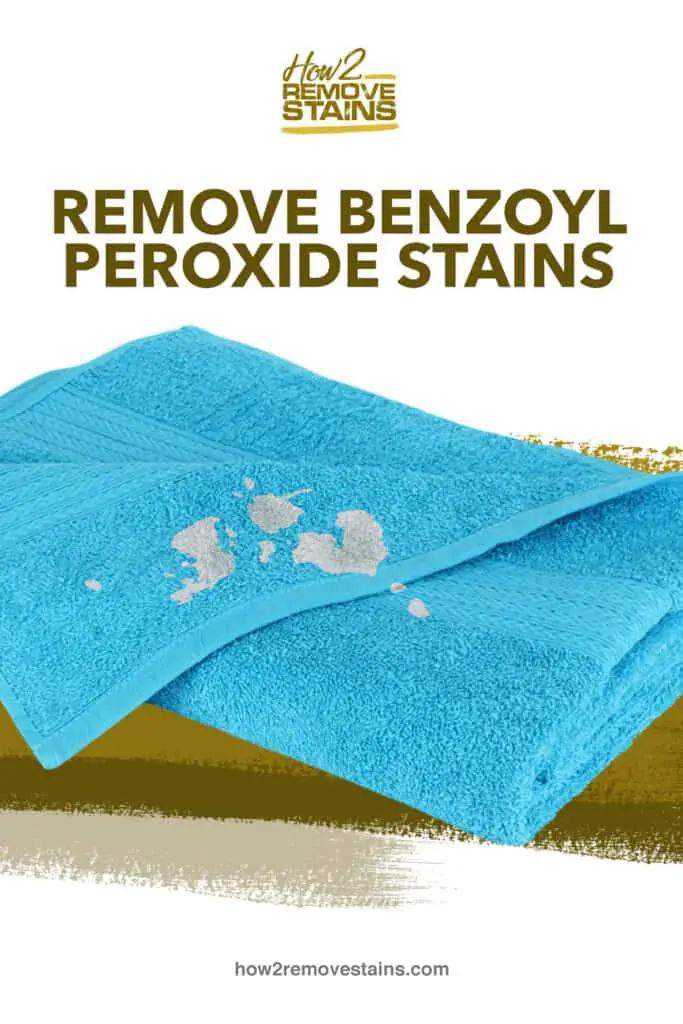Acne is a common skin problem a lot of people struggle with. Luckily there are medications and over-the-counter acne creams that can help people deal with their skin problems. One popular acne-fighting ingredient is benzoyl peroxide. Although it is great at clearing up acne, benzoyl peroxide is also known to stain clothes, towels and carpet fibers it comes in contact with. This ingredient can permanently bleach and discolor fabrics. Once benzoyl peroxide mixes with moisture, it converts to hydrogen peroxide, which can bleach fabrics. Read further to learn how to remove benzoyl peroxide stains effectively.
Table of Contents
Important considerations
If you’ve been using acne medication, there have probably been instances where it rubbed onto your clothes, or even worse, your dry-clean-only fabric. If this occurs, use a dull knife to remove any leftover residue. Quickly submerge the stained area with cool, plain water by blotting with a white towel dipped in water. After the fabric has been moistened, use a dry white cloth to blot away any lingering moisture.
Quickly bring the garment to a professional cleaner and identify the stain. Remember to not let the stain to stay on the fabric for a long time and avoid exposure to warm temperatures, since it might allow the stain to set permanently.
Steps to remove benzoyl peroxide stains
Let’s take a look at the steps on how to remove benzoyl peroxide stains from your clothes.
- When an over-the-counter or prescription acne cream directly comes in contact with any white or colored washable fabrics, the first move is to use a dull knife or spoon to get rid of any lingering residue from the surface. Avoid rubbing since it will only drive the medication deeper into the fabric fibers.
- Position the fabric under cool running water from a faucet. Flush from the opposite side with the fabric directly under the faucet. With this technique, the water will drive the medication out of the fabric fibers.
- Quickly wash the fabric as recommended on the fabric care label. Remember that if bleaching starts on the fabric, it can’t be reversed anymore.
- In some instances, benzoyl peroxide and other ingredients mix with the fabric dyes to produce an orange or rust-colored stain. This stain might also be permanent if not dealt with right away. One technique to get rid of the discoloration is to fill a sink or large tub with cool water and an oxygen-based bleach. Fully submerge the fabric with the stain and leave it in place for at least 4 hours or even overnight. This process is safe to use on all white fabrics and colored washable clothes except for wool, silk or those with leather trims.
- Inspect if the stain is gone and wash the fabric normally. If a trace of the stain lingers, prepare a mixture of fresh oxygen bleach and water and repeat the process above. In some cases, it might take several treatments to completely remove the stain.
Tips on how to prevent benzoyl peroxide stains
- Wash your hands thoroughly with hot water and soap after applying the medication. This will prevent any accidental transfer to fabrics.
- Allow the medication to completely dry before getting dressed or going to sleep.
- Avoid tossing any washcloths or towels that might have acne medication smudges or residue into the clothes hamper since they can stain other clothes.
- When using an acne medication, switch to white towels and sheets that will not reveal the signs of bleaching in the long run.
[crp]
Will peroxide damage clothes?
A bottle of hydrogen peroxide in your first aid cabinet has many purposes, including whitening white fabrics, brightening colors, eliminating stains and odors, as well as disinfecting your washing machine.
Hydrogen peroxide is an oxidizing product that you can use as laundry bleach. The 3% solution available in pharmacies as a first-aid antiseptic is the ideal choice for laundry and will not damage clothes. It is safe to use on all washable, dye-stable fabrics. Hydrogen peroxide safely breaks down into water.
Remember that hydrogen peroxide is highly light-sensitive, which is why it is packaged in dark containers. It will lose its cleaning ability if transferred to a clear container. It is highly effective when newly opened and will continue to provide cleaning and disinfecting properties for up to 6 months.
Does benzoyl peroxide bleach skin?
Benzoyl peroxide is generally found in a variety of acne treatment products but this potent ingredient can trigger various undesirable effects. It is important to note that benzoyl peroxide is a harsh solution that can cause bleaching. When applied on the skin, it might cause the area to appear whiter and can also affect the color of your hair. Even your eyebrows can be affected if the same strands come into contact with the product regularly and repeatedly. Furthermore, it can also bleach clothing and other materials.
Can you mix hydrogen peroxide and baking soda?
Hydrogen peroxide is a chemical compound that is a mixture of water and hydrogen. This transparent liquid functions as a mild antiseptic and is available in various strengths depending on its purpose.
It is safe to combine hydrogen peroxide and baking soda. This combination can also be used along with toothpaste to whiten discolored teeth.
Final thoughts
For those who are using over-the-counter or prescription acne medications, you might see signs of bleaching or stains on your clothes or towels. If you want to get rid of the stains effectively, these steps on how to remove benzoyl peroxide stains can help get rid of them in no time.


